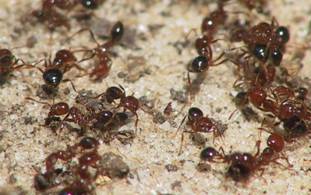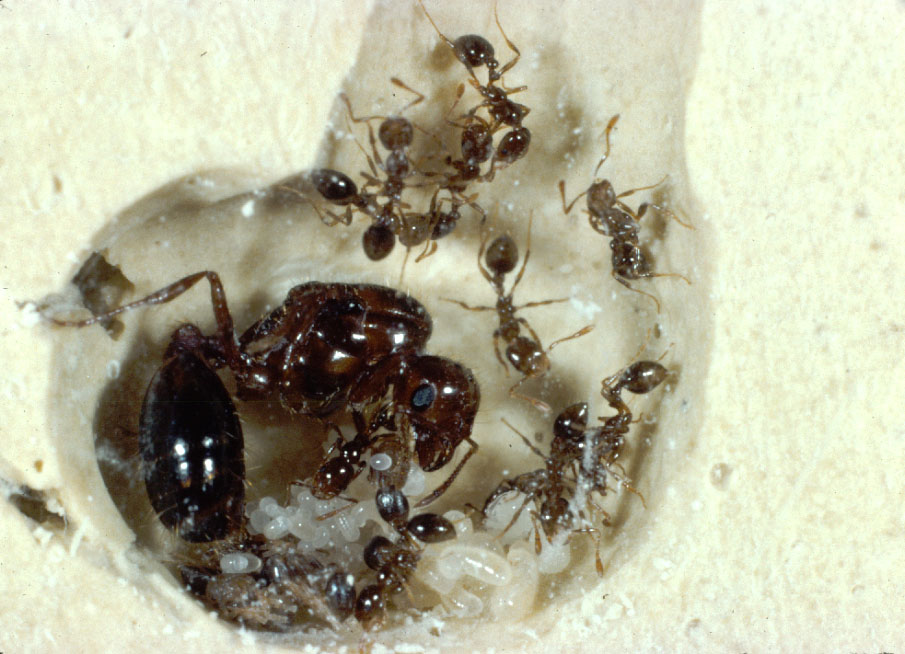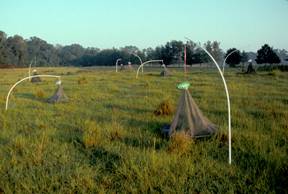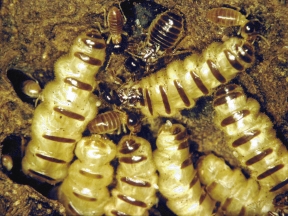Research Interests
Behavioral and population ecology of social insects
Our research group studies the behavior, ecology, and population biology of social insects, especially ants and termites. We are particularly interested in how cooperative and competitive interactions shape animal societies, populations, and communities. Social insects are wonderful subjects for studies connecting behavior to ecology. They are easily studied in both the field and the lab, allowing replicated experiments on whole societies. We work mostly with species that are important pests, that are invasive, or that are highly abundant and ecologically important members of temperate or tropical ecosystems.

The self-organization of conflicts between social groups
The behavior of social insect colonies is often viewed as a “self-organizing” phenomenon, in which the collective action of the group arises from numerous individual decisions, rather than from central control. Most studies on biological self-organization focus on a single society, whose members have common interests. However, antagonistic interactions between social groups are common in nature. We are interested in the dynamics of these conflicts, and how they are shaped by individual patterns of movement, response, and communication. Territorial battles among ant colonies provide conveniently studied examples.
Representative publications:
Adams, E.S. and M. Mesterton-Gibbons. 2003. Lanchester's attrition models and fights among social animals. Behavioral Ecology 14:719-723.
[pdf available on request]
Plowes, N.J.R. and E.S. Adams. 2005. An empirical test of Lanchester's square law: mortality during battles of the fire ant Solenopsis invicta. Proceedings of the Royal Society of London, Series B. 272:1809-1814.
[pdf available on request]
The INANE Project : INvasive
Ants of New England
Invasive organisms, including several species of ants, have substantial impacts on natural and agricultural ecosystems. We study two species of invasive ants in New England. (See also publications on fire ants, listed below.)
Nicola Plowes is concentrating on the biology of Tetramorium caespitum for her Ph.D. thesis research. She is examining the population structure of this species, and the mechanisms of territorial interactions among colonies.
In collaboration with Frank Drummond and Ellie Groden (University of Maine), we have developed microsatellite genetic markers for Myrmica rubra, which is among the few ants in New England that readily sting humans. We are examining the reproductive structure of colonies and local populations, as well as larger geographic patterns across the north-eastern United States.

Territorial
behavior and the population dynamics of ants
Territory defense is the classic example of a behavior with strong effects on population dynamics. We study territory defense from multiple perspectives to understand (1) the effects of territoriality on population dynamics, (2) the control of variation in territory size and shape, and (3) the mechanisms by which social animals defend territories. Our major study species has been the fire ant, Solenopsis invicta, an invasive ant which has become widespread in the southeastern United States, although our work on invasive ants is now being extended to other species.
Representative publications:
Adams, E.S. and W.R. Tschinkel. 2001. Mechanisms of population regulation in the fire ant Solenopsis invicta: an experimental study. Journal of Animal Ecology 70:355-369.
[pdf available on request]
Adams, E.S. 2001. Approaches to the study of territory size and shape. Annual Review of Ecology and Systematics 32:277-303.
[pdf available on request]
Adams, E.S. 2003. Experimental analysis of territory size in a population of the fire ant Solenopsis invicta. Behavioral Ecology 14:32-37.
[pdf available on request]

Population
Biology and Reproductive Skew in the
Termite Nasutitermes corniger
Some animal societies are characterized by highly unequal partitioning of reproduction, with a dominant individual monopolizing opportunities to produce offspring, while in other societies reproduction is shared more equitably. Understanding causes of variation in “reproductive skew” has been a major goal of studies on social animals. We study the control of reproduction in the neotropical termite Nasutitermes corniger. Colonies of this species vary widely in reproductive structure. Some colonies are simple families. Others contain multiple reproductives, which may be related or unrelated. Our research seeks to understand the origins of this variation in reproductive structure and its consequences for behavioral interactions. We are currently measuring patterns of reproductive skew within polygynous (multiple queen) and polyandrous (multiple king) colonies using microsatellite genetic markers.
Representative publications:
Atkinson, L., Adams, E.S., and Crozier, R.H. 2007. Microsatellite markers for the polygamous termite Nasutitermes corniger (Isoptera: Termitidae). Molecular Ecology Notes 7:299-301.
[pdf available on request]
Adams, E.S., Atkinson, L., and Bulmer, M.S. 2007. Relatedness, recognition errors, and colony fusion in the termite Nasutitermes corniger. Behavioral Ecology and Sociobiology 61:1195-1201.
[pdf available on request]
Atkinson, L., Teschendorf, G., and Adams, E.S. 2007. Lack of evidence for nepotism by workers tending queens of the polygynous termite Nasutitermes corniger. Behavioral Ecology and Sociobiology, in press.
Adams, E.S. and Atkinson, L. 2008. Queen fecundity and reproductive skew in the termite Nasutitermes corniger. Insectes Sociaux, in press.

Other research interests:
Dominance hierarchies:
Adams, E.S. 2005. Bayesian analysis of linear dominance hierarchies. Animal Behaviour 69:1191-1201.
[pdf available on request]
Game theory and competitive interactions:
Mesterton-Gibbons, M. and E.S. Adams. 2003. Landmarks in territory partitioning: a strategically stable convention? American Naturalist 161:685-697.
[pdf available on request]
Mesterton-Gibbons, M. and E. S. Adams. 1998. Animal contests as evolutionary games. American Scientist 86:334-341.
Threat communication:
Adams, E.S. 2001. Threat displays in animal communication: handicaps, reputation, and commitment. Pages 99-119 in Nesse, R. (ed.) Evolution and the Capacity for Commitment. New York: Russell Sage Foundation.
Adams, E.S. and M. Mesterton-Gibbons. 1995. The costs of threat displays and the stability of deceptive communication. Journal of Theoretical Biology 175:405-421.
[pdf available on request]
Adams, E.S. and R.L. Caldwell. 1990. Deceptive communication in the stomatopod crustacean Gonodactylus bredini. Animal Behaviour 39:706-716.
Termite population biology:
Bulmer, M.S., E.S. Adams, and J.F.A. Traniello. 2001. Variation in colony structure in the subterranean termite Reticulitermes flavipes. Behavioral Ecology and Sociobiology 49:236-243.
[pdf available on request]
Thorne, B.L., J.F.A. Traniello, E.S. Adams and Bulmer, M. 1999. Reproductive dynamics and colony structure in subterranean termites of the genus Reticulitermes. Ethology, Ecology, and Evolution 11:149-169.
Atkinson, L. and E.S. Adams. 1997. Double-strand conformational polymorphism (DSCP) analysis of the mitochondrial control region provides high resolution genetic markers for population studies in a social insect. Insect Molecular Biology 6:369-376.
[pdf available on request]
Adams, E.S. 1991. Nestmate recognition based on heritable odors in the termite Microcerotermes arboreus. P.N.A.S., USA 88:2031-2034.
[pdf available on request]
Bayesian Statistical Analysis:
Adams, E.S. and Atkinson, L. 2008. Queen fecundity and reproductive skew in the termite Nasutitermes corniger. Insectes Sociaux, in press.
Adams, E.S. 2005. Bayesian analysis of linear dominance hierarchies. Animal Behaviour 69:1191-1201.
[pdf available on request]
Plowes, N.J.R. and E.S. Adams. 2005. An empirical test of Lanchester's square law: mortality during battles of the fire ant Solenopsis invicta. Proceedings of the Royal Society of London, Series B. 272:1809-1814.
[pdf available on request]
Ant community ecology:
Adams, E.S. 1994. Territory defense by the ant Azteca trigona: Maintenance of an arboreal ant mosaic. Oecologia 97:202-208.
Adams, E.S. 1990. Interaction between the ants Zacryptocerus maculatus and Azteca trigona: Interspecific parasitization of information. Biotropica 22:200-206.